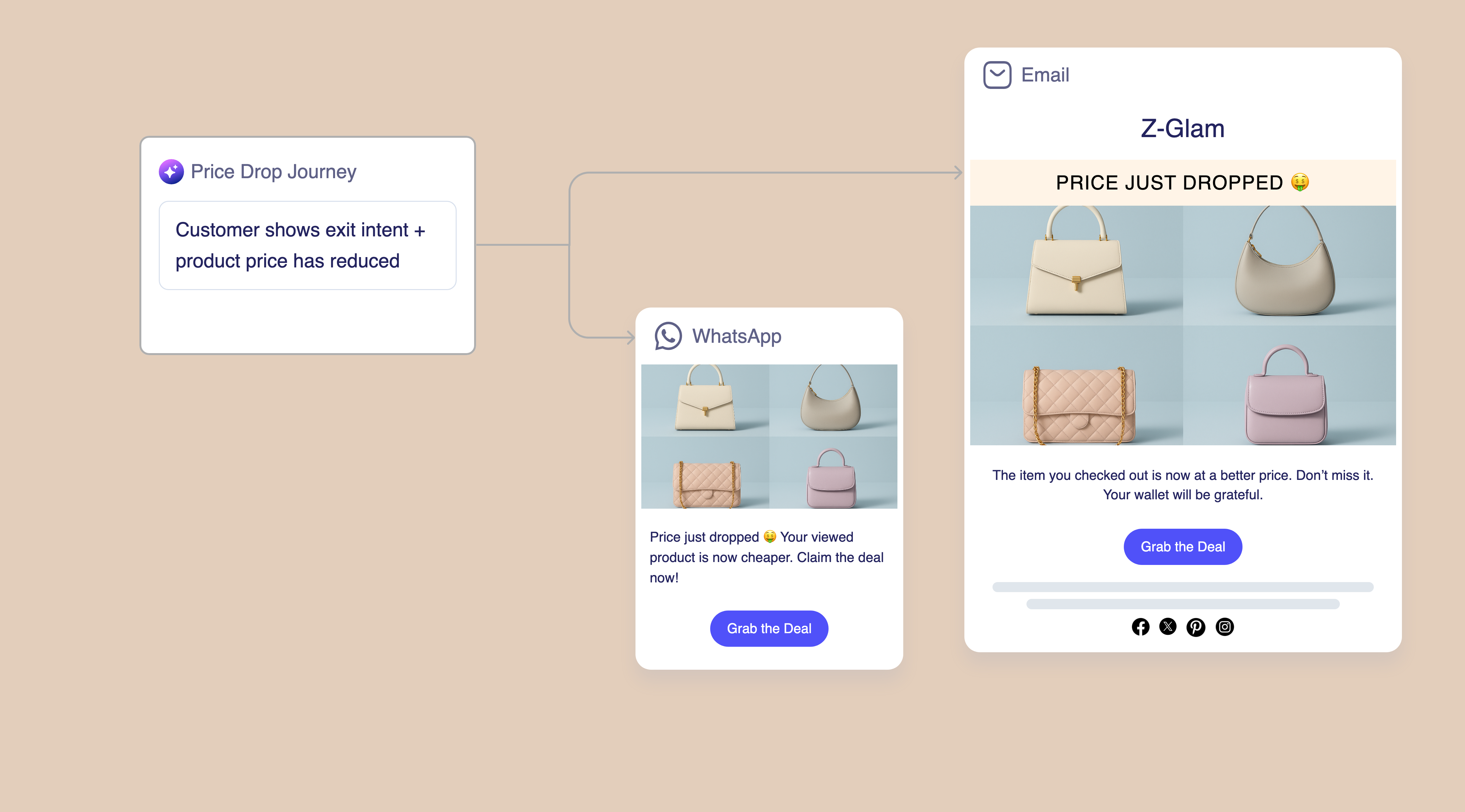
Price Drop Recovery
Recover revenue from exit-intent users by alerting them when items they showed interest in become cheaper.

What are Price Drop Recovery campaigns?
Price Drop Recovery campaigns target exit-intent users and price drop triggers who showed exit behavior and were browsing items that dropped in price by triggering nudges with CTAs when price drops on items users showed exit intent on. This revenue recovery strategy leverages price sensitivity as a conversion trigger, turning price-conscious abandoners into buyers through strategic discount alerts.
Why Price Drop Recovery Matters

Challenges

Opportunities
Outcomes
Higher Conversion from Price-Sensitive Users
Recovered Revenue from Exit Behavior
Better Price Optimization Insights
Who is it for?
Audience
Exclusions
How it Plays Out
A sample sequence for this use case.
Good news - it's cheaper now! The Leather Handbag you checked out just dropped in price. Grab it now → [Shop the deal]
Hey [Name], price just dropped on the Leather Handbag you viewed last. Time to claim the deal → [Get it now]
Still thinking about that Leather Handbag? The price drop won't last forever → [Secure Savings]
Final reminder: Your price drop deal expires soon → [Don't Miss Out]
Best Practices
- Send price drop alerts immediately when reductions occur to capitalize on the urgency of limited-time savings.
- Reference specific products users viewed during their exit session to create personal relevance.
- Include clear savings amounts or percentages to emphasize the value improvement since their last visit.
Price Drop Recovery Examples & Prompts
Channel Examples
Automate with Zenie Prompts
Tracking prices and aligning them with user activity is complex. With Zenie, you can automate it end-to-end, and match discounts with intent signals in real time.

Segment users who viewed, carted, or wishlisted products now flagged with price drops
Explore Similar eCommerce Marketing Strategies
FAQs
Why are price drop recovery campaigns effective for exit-intent users?
Price drop recovery campaigns work because they directly address the primary concern that caused exit behavior—price sensitivity. D2C marketers see higher conversion rates when they can prove value improvement since the customer's last interaction.
How should eCommerce brands identify which exit-intent users to target for price drops?
D2C businesses should focus on users who spent significant time on product pages, compared prices, or showed other price-conscious behaviors before exiting. These indicators suggest price was a primary purchase barrier rather than a lack of interest.
What types of price drops are most effective for recovery campaigns?
Meaningful discounts of 15-30% work best for price drop recovery campaigns, as they represent substantial savings that justify return visits. eCommerce marketers should avoid minor price adjustments that don't feel significant to price-sensitive customers.
Should price drop recovery campaigns highlight savings amounts specifically?
Yes, D2C brands should clearly communicate the exact savings amount or percentage to emphasize the value improvement. Specific savings figures like "Save $50" or "30% off" create stronger motivation than vague discount language for eCommerce businesses.
How do eCommerce businesses measure price drop recovery campaign success?
Track conversion rates from price drop alerts, revenue recovered from exit-intent users, and average order values from recovery campaigns. Monitor whether price drop buyers become regular customers or remain exclusively price-sensitive purchasers.

